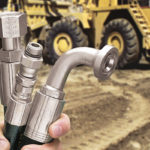By Josh Cosford, Contributing Editor
Do me a favor — stand up near a wall just out of arm’s length reach. Now raise your arm with your palm facing the wall and very slowly move toward the wall. Without yet touching the wall, tell me where the force comes from to move your body close to the wall. I hope each of you said aloud, “from me!” before your colleagues peered to see to whom you were talking.

Now continue moving until your palm is pressed firmly against the wall. We can agree that there is pressure between your palm and the wall. Where did that pressure come from? The wall? No, it came from you, pushing your hand against the wall. The pressure exists only because the wall is resisting, just as Newton’s Third Law would predict (every action has an equal and opposite reaction).
In the above example, did the wall — in any way — create force? Any grade-schooler would agree the force came from you, so why do we continue to believe counterintuitive claims such as “pressure is resistance to flow?” First, we must consider that pressure and force aren’t always interchangeable, mainly because only force can create pressure. We literally define pressure as force over a defined area, so the force component is a given.
I agree that resistance is half the equation, and without the wall resisting your hand in my first example, your hand would continue to hang out in free air while your colleagues stared bemusingly. But the pressure (and therefore, force) did not start at the wall. In hydraulics, you may argue that flow is not pressure — that it’s some kind of dynamic entity that flows freely like the wind until met with resistance. But force can only operate “downhill,” as it were, meaning it must come from an area of higher potential to one of lower potential. I know what you’re thinking, but magnetism isn’t a real force — don’t @ me.
Pressure always starts at the pump. The source of energy in a hydraulic system is the prime mover, which imparts energy into our hydraulic transformer, also known as a pump. Our pump imparts force upon the hydraulic fluid, sending it in motion. Even if we assume a straight pipe exits the pump with no restriction, some friction from the pipe (or even air) must be overcome, creating fractional psi on a highly sensitive pressure gauge.
The same can be said for an entire hydraulic system. Even a tiny circuit running a hydraulic motor with no load will still see nominal pressure overcoming friction inside the plumbing and the motor’s internal moving parts. However, if we take that motor and run it through a thousand feet of hose some distance from the pump, pressure gauges at the pump will read much higher than at the motor’s work port, even with no load. If the claim that pressure starts at the resistance, then pressure at the motor should be higher than at the pump. However, such an example would see our hydraulic fluid moving backwards!
Clearly, hydraulic circuits work as intended because they follow the laws of physics. A hydraulic pump pushing on hydraulic fluid is no different from someone pushing on a solid rod – the transfer of force occurs no differently, only that hydraulic oil is a slightly compressible fluid. There is no way to skirt the laws of nature — pressure makes it go. So if you’re in Detroit for the Fluid Power Technology Conference this October 12-13, be sure to schedule some time for my live presentation, Debunking Flow Makes It Go.






